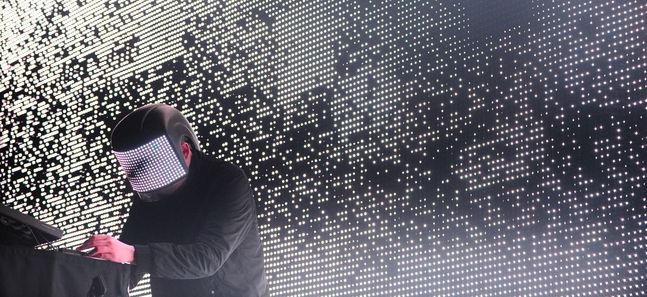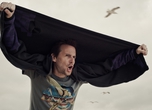Squarepusher: the interview
The veteran producer brings his ‘Ufabulum’ show back to Tokyo

Posted: Mon Nov 19 2012
For the past two decades, Tom ‘Squarepusher’ Jenkinson has been one of electronic music’s true iconoclasts, from his early hyper-breakbeat material to the recent Ufabulum, an album that fuses his spiky rhythmic sense and love of sweeping melody. He’s spent most of 2012 on tour with a live show that presents the new music with an intense audio-visual flourish; after appearing with an early version of the show at SonarSound Tokyo in April, he returns for this weekend’s Electraglide 2012 at Makihari Messe.
You’re in the middle of what must be one of your biggest tours ever, right?
Yeah, but I’ve got a few days at home right now – which, lately, is a rare occurrence. In terms of doing shows, this has been non-stop; the first one was in March, and it hasn’t really let up since then.
Between the tour, the intricacies of the show itself, the live EP, the album’s glow-in-the-dark packaging, the T-shirts and everything else, it seems like you’ve really gone all-in with this album. Is there any particular reason for that, other than the fact that it’s a pretty great record?
Well, I’m not sure everyone would agree with that. [Laughs.] But I suppose each set of music determines, to a point, what I end up doing with it. For something to end up on a record, it has to be of a certain standard; I don’t put things out just for the sake of it. Before I even think about things like artwork, live versions and whatever else might end up happening with it, I have to have some degree of confidence that there’s some originality in it, whether that has to do with the techniques with which it was made, or the harmonic aspects or composition, and so on. Once a track has fulfilled that set of criteria, it’s really just down to the nature of the music as to what happens from there.
Can you give an example of that?
Some records don’t really adapt well to a live context at all, for instance, so I won’t even try. It all stems from the material. Some things I like to keep very simple. I did a record a few years ago of electric-bass pieces [Solo Electric Bass 1] that was recorded live, with no messing about in the studio or anything. There was no editing; the amount of time it took to play the pieces was the amount of time it took to record. And that led me to want to release it in a very no-fuss fashion. No merchandise, no tour: just put it out and make it available to people.
But Ufabulum is obviously a very different record.
Yeah, I suppose these pieces seemed like they would adapt very well to a live context, with a whole show built around the pieces. The live show adds a bit of momentum to them. It’s funny, because I don’t really have much of a vision regarding packaging of music; I’m usually not that involved, beyond the images on the artwork. I’m normally quite happy to leave it to others as far as anything that happens beyond that.
You just mentioned your live-bass album, and you’ve incorporated quite a bit of live instrumentation on many of your releases, but with Ufabulum, you’ve opted to make a fully programmed record. Why is that?
My approach to making music has always oscillated between two poles, one of which is a programmed, strictly controlled, almost clinical approach; the other is instrument based, trying to harness the idiosyncratic things you get out of live performance. I enjoy that contrast, but it felt as though the live-performance aspect had come to dominate my work over the past five or six years, so it felt like it was very much time to swing back in the opposite direction – and swing back quite violently, really.
So the decision was that simple?
Well, in addition to the mundane factor of simply wanting a change, that sentiment was accompanied by a reasonably well-formed vision of what the album would sound like – not just in terms of techniques, synthesis processes and so forth, but also in the actual harmonic approach. I suppose the ideas came to me in fairly well-formed fashion.
You didn’t just walk into the studio and say, ‘Let me start fooling around with this stuff and see what happens’?
No, not at all. I’d be lying if I said that there weren't certain things on the album that came about by accident. But it’s certainly a creature of this closely controlled attitude towards all of the aspects that were in my control.
Some of the tracks seem a bit reminiscent of your that hyper, jazz- and drum ’n’ bass-derived sound of your earlier work, while building upon it. Was it your intention to revisit that sound?
Well, I must admit I feel a little bit uncomfortable with that idea. I feel like we are venturing into the world of the public perception and the critical assessment of what I’ve done – which, obviously, is fair game. But still, I try to leave those concentric circles, which take you further away from the core musical activity with which I’m involved, to others. Those are interpretative, contextual concerns that I personally would like to leave open, and leave it for others to think about. I suppose I’m a little bit too close to know, anyway. I’d be misleading you if I said that I’m completely, wholeheartedly aware of everything I do when I make music; quite often, motifs and intentions don’t become apparent to me until well after I’ve made the record.
I imagine that’s true with a lot of people involved in making music, or art of any sort.
Yeah. I’m not totally convinced when I read people talking about making records, how they were fully aware of everything what they were trying to do. There are always things that escape their control, and even escape their awareness. I mean, I’m aware there are certain resonances between this work and my earlier work, but if I take a step back and look at it, I don’t feel that the link is as strong as some other people think. And if I thought it was that strong, I probably wouldn’t have released the record. The things that I put out into the public domain have got to have some degree of originality. If I’m just echoing what I’ve done before, or what other people have done before, I don’t really think there’s any point.
If other people followed that credo, there probably wouldn’t be much music coming out.
Yeah, there’s just so much music being released. My only justification for adding to that is my belief that there’s some degree of originality to what I’m doing. Which is not to say there isn’t any point in copying people, or copying your own work; that’s how you learn, among other things. But overall, I’m not going to agree with the idea that I’m echoing my earlier work.
I certainly won’t try to convince you…
The other thing is that when I listen to those early records, the problem I have is that they feel so claustrophobic, so lacking in space. If nothing else, I think I’ve gotten better at using space in music.
The early releases were certainly very dense records.
Exactly. Which was fully in keeping with my outlook at the time, which was to try and make something akin to musical insanity. I wanted them to be disorientating and… well, not actually aggravating, but something approaching the limit of comprehensibility. As much as I still find that idea fascinating, I think I’ve moved away from that. Or, at least, I’m trying to do it in a more subtle, sophisticated way. But these are the kinds of questions I’d rather leave to other people.
You’d rather let the listeners make up their own minds about the music.
Part of the fun of music – the enjoyment of it – is to come up with your own ideas as to what it’s about. I’m not of the idea that the artist’s take on their music is the sovereign, most important take, and that everyone else should just echo that. I’d much rather people come up with their own interpretation. I’m much more comfortable talking about technical details; they’re facts, incontrovertible facts. When it comes to evaluation of music, that’s a bit too free-floating for me.
But you are offering one interpretation of Ufabulum – at least in an abstract, visual way – through the visuals that are a big part of the live show.
That’s a very good point. All I can say is you don’t have to watch the visuals; the album is the core thing. The visual interpretation is very much offered on a ‘this is how I see it’ kind of basis.
In what specific ways do the visuals relate to your interpretation?
First and foremost, let me say that I was working on the visual aspect at the same time I was working on the music. Part of the motivation to do that was to try to form as strong a link as possible between my visual interpretations and the sound itself. But I also just wanted to see if the ideas that I was coming up with, regarding how to express the music visually, would feed back into the music itself. Anyway, broadly speaking, what I’m trying to do with the imagery is to show what this music produces in my mind’s eye: what kinds of patterns and shapes and narratives the music evokes for me. I agree it’s a tricky spot: I’m maintaining that anyone should be able to have a free interpretation of this, but I’m offering quite a strong… not a guideline, exactly, but a very strong example of how I personally interpret it. I suppose all I can say is that I don’t expect everyone to accept it; it’s just there if you want to check it out. You can shut your eyes, but you can’t shut your ears.
I suspect that not many people who are coming to your shows are shutting their eyes.
We’ll see! [Laughs.] It’s an experiment, really. I’m not saying it’s entirely successful, and I’m happier with some parts of it than I am with others. Nonetheless, as I said, it’s an attempt to express what this music produces for me in my mind’s eye. That’s been a big part of my experience in listening to music since I was a kid. Music’s always produced visual corollaries for me.
Would you consider that trait to be akin to synesthesia?
I suppose it is, but I’m not really trying to define what it is. I should say that some music doesn’t make me think of anything, really. It’s not like it’s happening non-stop, nor is it a repeatable process; a piece of music may evoke something, and the next day it doesn’t. I dare say that’s the same for other people as well. It could be somewhat mood-dependent or context-dependent.
You’ve been performing this show for a number of months now. Has it evolved much over that time?
Sonically, yes, but not visually. I started out with the idea that I was going to be doing live manipulation of the imagery, which is something that I had never tried to do before. I found, quite quickly, that it wasn’t very satisfying; I wasn’t able to generate any kind of interesting progression from the core material. It just seemed like anything I was doing was compromising the visuals, rather than bringing anything new to them. So I’ve steered away from that, and concentrated my efforts on sonic reinterpretation. I find that much more satisfying, which may be simply because I’m much more experienced doing that. That’s where the developmental effort has gone.
Can you actually see through that light-up mask that you wear in the show?
It’s got a limited degree of visibility. I use it primarily to make myself part of the canvas, if that doesn’t sound too pretentious. I don’t see myself as a showman or a great performer – and when I say performer, I’m making a distinction between that and a player. I think that some people are very good at introducing an element of theatre into their stage manner, but I’ve never been comfortable, or interested, in doing that. I suppose there’s a certain degree of default stagecraft that I’m in possession of, but I don’t want to be the centre of attention. Again, I’m caught in a bit of a tricky spot, in terms of why I do it. Of course, there are many reasons to do it, but there are many things about it that make me uncomfortable in doing it. In the end, I’m doing it because I think I have something to offer.
In past interviews, you’ve spoken about what you call ‘cult of personality’ performers.
Yes, I always tried to get way from that. It tends to always build up around the main figure on the stage. When I started doing shows as Squarepusher years and years ago, I actually used to set up behind the PA stacks. I didn’t even want to be on the stage. That was one of the things that I really liked about raves in the early ’90s; the audience wasn’t even looking at the DJ or the stage, but was more concerned with simply listening to the music and having an enjoyable time. It was such a refreshing thing: rather than idolising performers, people would have an uninhibited route to the music itself. There’s a legacy of that in what I’m trying to do, I think. Yes, I’m the person bobbing about on the stage with a mask on, but I’m trying to make myself a way of displaying images, rather than be an image myself. But there’s no truly clean way out of my dilemma.
Whatever the case, the whole set-up, including the mask, looks pretty cool.
From what I’ve seen of the footage, it seems to work. It seems to be fairly satisfying. The mask allows me a different visual space; the images can be delivered in a two-part form. There’s the element that’s shown on the mask, and the element that’s shown on the screen behind me. That offers quite a bit of potential. You can have a kind of polyrhythmic visual approach, by bouncing the images between screens. There is definitely rhythmic potential for counterpoint between sound and image.
You have as singular a sound as almost anyone in electronic music, but in the process of this tour, you’ve been exposed – at least in an ambient way – to the artists you’ve been playing with. I’m sure that’s been true throughout your career. Do you pay attention to the music going on around you, or do you try to keep isolated from it?
Well, by virtue of what I’ve been doing throughout my career – especially this year, when I’ve been doing all these festivals and live shows – I can’t avoid hearing other things. I do have a degree of awareness of what other people are doing, and I actually do feel it’s rather healthy. But my main issue, perennially, is to try and catch up with my own ideas, before they become vague and indistinct. I have to try and realise those ideas while they’re fresh, and a bit of a problem I’ve always been aware of is that hearing and concentrating on what other people are doing makes it harder for me. I’m not saying my ideas have never been influenced by outside forces, but I’m always trying to work on those ideas in the form that they come to me. I’m always trying to get them into some form of musical shape. I suppose it’s always been kind of an experiment for me, just to see what I’ve got. It’s certainly not always what fans of electronic music want to hear – but at the same time, I think I’m offering some tangents that other people have never considered. There’s no manual in terms of how I approach composition, but this is the way that suits me. Of course, when I run out of ideas, I may change my outlook.
Squarepusher plays at Electraglide 2012, November 23 at Makuhari Messe
Read Electraglide 2012: the interviews
Tweets
- About Us |
- Work for Time Out |
- Send us info |
- Advertising |
- Mobile edition |
- Terms & Conditions |
- Privacy policy |
- Contact Us
Copyright © 2014 Time Out Tokyo














Add your comment